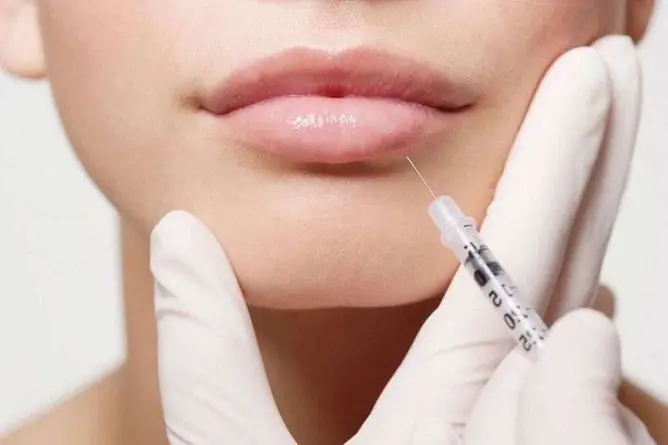- Author Rachel Wainwright [email protected].
- Public 2023-12-15 07:39.
- Last modified 2025-11-02 20:14.
Swelling after lip augmentation: how to remove, why it occurs and how it manifests itself
The content of the article:
-
What to do if your lips are swollen after augmentation with hyaluronic acid
- Massage
- Hyaluronidase
- Compresses and masks
- Prevention of edema with lip augmentation
- How to remove swelling after lip augmentation: recommendations
- What not to do after filler injection
- Why lips can swell after filler injection
-
How does the edema appear and when does the edema decrease after the filler injection?
Allergy
- Video
Edema after lip augmentation with hyaluronic acid or other drugs is observed in almost everyone who undergoes this procedure. In most cases, it goes away on its own and rather quickly, and does not require treatment. However, there are exceptions.

Swelling is normal after hyaluronic acid injection
Before carrying out the manipulation, the cosmetologist collects the patient's anamnesis. At the same time, special attention is paid to the presence of allergies to drugs, as well as certain diseases. So, if a person develops herpetic eruptions, a course of antiviral drugs is usually prescribed to him before the procedure. With exacerbations of herpes, manipulation is contraindicated.
Many injectable preparations in cosmetology (fillers) for contouring without surgery are made on the basis of hyaluronic acid. With the proper qualifications of a cosmetologist, their introduction relatively rarely leads to the development of adverse consequences. However, after manipulation, the edema does not subside for a long time or takes pathological forms, you should immediately seek medical help.
What to do if your lips are swollen after augmentation with hyaluronic acid
Excessive edema can occur with excessive filler injection or when the drug is not injected deeply enough. To eliminate it, physiotherapy procedures and massage are usually prescribed. If the lips are swollen and bruises appear, heparin ointment is prescribed.
If seals (granulomas, balls) have formed, surgery may be required to remove them.
Massage
To improve the blood supply to the lips after injection and to evenly distribute the filler, massage is used, for which it is best to consult a specialist. The patient can perform self-massage, but only after consulting a doctor and mastering the massage technique under the supervision of a specialist. Massage usually consists of a gentle circular and patting motion for a few minutes.
If everything is done correctly, the bumps on the lips after the injection of the filler should go away on their own. If this does not happen, you can also remove the formed seals with massage.
Hyaluronidase
If uneven seals appear, it may be necessary to remove the filler from the tissues, which is carried out by introducing agents that destroy hyaluronic acid. For this purpose, a solution of hyaluronidase, an enzyme that dissolves hyaluronic acid, is injected into the injection site. Patients with allergic reactions are also administered hyaluronidase, antihistamines are prescribed.
Compresses and masks
Compresses from decoctions or infusions of medicinal plants help to reduce puffiness after the procedure at home:
- calendula;
- succession;
- chamomile medicinal;
- walnut leaves.
Ice cubes wrapped in a sterile tissue can be applied to the mouth area for a short time. Usually such procedures are recommended to be carried out several times a day. To increase efficiency, you can use frozen decoctions or herbal infusions. It is usually allowed to start making masks a few days after the filler is injected into the lips.
Before using any means and methods of traditional or traditional medicine, you should consult your doctor.
Prevention of edema with lip augmentation
It is possible to minimize the adverse consequences after the procedure by following a number of rules in preparation for manipulation:
- It is not recommended to inject the filler during menstruation, as well as a few days before and several days after it, since a change in hormonal levels can cause the development of severe swelling, bruising, during the procedure, the patient may feel more discomfort due to changes in pain sensitivity in this period.
- You cannot resort to lip augmentation during colds, exacerbations of chronic diseases.
- If you are prone to allergies, it is recommended to start taking antihistamines a few days before the procedure.
- At the first session, you should not enter the maximum permissible dose of the drug, start with a minimum.
How to remove swelling after lip augmentation: recommendations
The table shows a number of recommendations for lip care after filler injection:
| Recommendation | Explanation |
| Use hypoallergenic moisturizers | Especially useful are products that contain oils |
| Make nourishing and moisturizing masks | At home, for this purpose, you can use cream, sour cream, cucumber juice, honey |
| Apply cold compresses to lips | It is usually recommended to do such compresses on the lip area during the first day after manipulation. |
What not to do after filler injection
Immediately after the procedure, you usually do not:
- take food for 4-6 hours;
- Avoiding kissing, which can interfere with the normal distribution of filler, increase swelling and cause bumps
- consume alcoholic beverages, which can irritate the skin of the lips and mucous membranes. If you stop drinking alcohol, the swelling after the injection of the filler will go away faster.
Later, soft foods, semi-liquid and liquid foods should be eaten, avoiding too hot and too cold to minimize the risk of food injury to the skin of the lips.
For some time (the exact terms of the restrictions are usually indicated by the doctor) it is not recommended:
- the use of decorative cosmetics;
- smoking (due to the harmful effects of mechanical, thermal, chemical irritants);
- baths, saunas, solariums;
- prolonged exposure to direct sunlight;
- intense physical activity.
In addition, for some time after the injection of the filler, it is not recommended to visit the pools, swim in natural reservoirs, since during this period the risk of infection through punctures and skin microtrauma increases.
After the introduction of hyaluronic acid, you should fight the habit of licking your lips (if any).
Why lips can swell after filler injection
The cause of puffiness after the injection of hyaluronic acid is the reaction of tissues to injections and microtrauma.
Bruises and swelling can occur due to rupture of the capillaries during the injection, normally they disappear within a week after the procedure. Balls under the skin can appear if the patient's body rejects the filler, with insufficient kneading of the injectable preparation.

Bruises are the result of trauma to the capillaries during the injection
A number of patients have significant edema, which can persist for a long time. The reasons for this phenomenon may be errors during the operation (including determining the type of drug injected and its dosage). Therefore, to carry out the procedure, it is advisable to contact a qualified specialist.
The development of pathology is also possible through the fault of the patient (for example, in case of non-compliance with the recommendations for preparing for the operation, the rules of post-care).
Risk factors for edema include the human consumption of food a few days before the procedure and after it, excessively salty, spicy, smoked, spicy foods.
The presence of a number of systemic diseases of internal organs in the patient can contribute to the occurrence of bruising and bruising after manipulation.
How does the edema appear and when does the edema decrease after the filler injection?
Usually, the beautician performing the procedure warns of the possible development of puffiness after the injection of the filler. How long the swelling lasts depends on the characteristics of the body, the presence or absence of proper lip skin care and a number of other factors. The swelling usually subsides within three days after the manipulation.
In patients who are prone to edema, the swelling in the mouth area after the procedure may persist longer (up to about 10 days). Swelling can also last longer if too much drug has been injected, or the body temperature has been raised.
In addition to puffiness, the consequences of the procedure with hyaluronic acid can be:
- bruising;
- balls (granulomas);
- the development of an allergic reaction.
In some cases, bruises after an injection of the drug can spread far beyond the injection, which is a reason for an immediate visit to a doctor. If the drug is not injected deeply enough, the lips may look bumpy, unnaturally swollen.
When balls form on the lips, the patient may feel discomfort (even if they are not visually noticeable). With the development of complications in the patient, an increase in body temperature is possible.
Allergy
In case of an allergic reaction to the filler, in addition to edema, itching, urticaria, and hyperemia of the skin may occur. In some patients with allergies, a complication after the administration of the drug may be the development of Quincke's edema, a dangerous life-threatening condition that requires emergency medical attention. This is one of the reasons why only a qualified specialist should carry out the procedure.
Video
We offer for viewing a video on the topic of the article.

Anna Aksenova Medical journalist About the author
Education: 2004-2007 "First Kiev Medical College" specialty "Laboratory Diagnostics".
Found a mistake in the text? Select it and press Ctrl + Enter.






